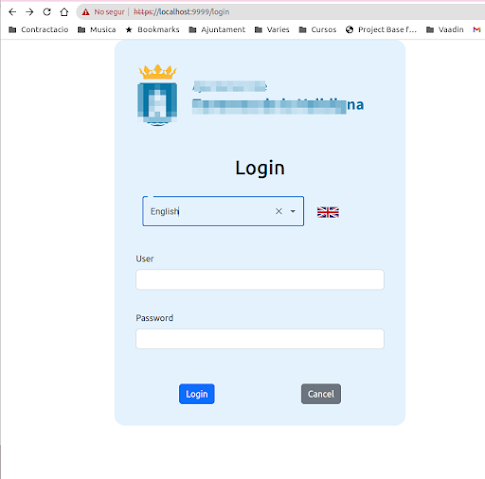10. React deployment on Nginx (5). Passing client certificate DN to react client
0. Nginx installation
#------------------------------------------------------ # INSTALLATION # @see Mohammad Faisal #------------------------------------------------------ #1. Install nginx sudo apt-get update sudo apt-get install nginx #2. verify installation sudo nginx -v #------------------------------------------------------ # STARTUP SETTINGS #------------------------------------------------------ #start Nginx when server restarts sudo systemctl enable nginx #only for checking if nginx is running systemctl status nginx
sudo nano /etc/nginx/sites-available/default (OLD VERSIONS of NGINX !!!)
In newer versions of nginx use this file instead
sudo nano /etc/nginx/conf.d/default.confserver { #listen 80 default_server; listen 8081 default_server; #listen [::]:80 default_server; listen [::]:8081 default_server;
#root /var/www/html; root /home/ximo/my-react-app # Add index.php to the list if you are using PHP #index index.html index.htm index.nginx-debian.html; index index.html; server_name _; location / { # First attempt to serve request as file, then # as directory, then fall back to displaying a 404. #try_files $uri $uri/ =404; try_files $uri $uri/ /index.html index.html =404; }
sudo systemctl restart nginx.service
sudo netstat -tlpn| grep nginx tcp 0 0 0.0.0.0:8081 0.0.0.0:* LISTEN 12749/nginx: master tcp6 0 0 :::8081 :::* LISTEN 12749/nginx: master
1. Deploying react program to Nginx
Once you have tested your app, after executing npm run build , copy the contents of the build folder to the folder /home/ximo/my-react-app as shown in the file /etc/nginx/sites-available/default as shown in the previous section
The folder my-react-app is as follows
sudo systemctl restart nginx.service
2. Enabling HTTPS
1. Nginx needs a certificate and a key (both in pem format) If you have other formats, you can see how to convert it in a previous post.
2. The SSL certificate chain or CA certificate chains are usefull for discovering which CA can provide accepted user certificates. Mozilla helps us with a collection of CA chains. (The Mozilla file is named cacert.pem)
The file /etc/nginx/sites-available/default (in old versions of nginx!!!)
or /etc/nginx/conf.d/default.conf (in new versions of nginx) is
#================================================================== # HTTPS SERVER #================================================================== server { # SSL configuration # # listen 443 ssl default_server; listen 9999 ssl default_server;
# listen [::]:443 ssl default_server; listen [::]:9999 ssl default_server; ssl_protocols TLSv1 TLSv1.1 TLSv1.2; #ssl_ciphers AES128-SHA:AES256-SHA:RC4-SHA:DES-CBC3-SHA:RC4-MD5; ssl_certificate /home/ximo/my-react-app/keystores/mycrt.pem; ## ssl_certificate_key /home/ximo/my-react-app/keystores/mykey.pem; ## ssl_client_certificate /home/ximo/my-react-app/keystores/cacert.pem; ## CA Bundle ssl_verify_client on; #root /var/www/html; root /home/ximo/my-react-app; # Add index.php to the list if you are using PHP #index index.html index.htm index.nginx-debian.html; #index index.nginx-debian.html; index index.html; server_name _; location / { # First attempt to serve request as file, then # as directory, then fall back to displaying a 404. #try_files $uri $uri/ =404; try_files $uri $uri/ /index.html index.html =404; } } #================================================================== # HTTP SERVER #================================================================== server { #listen 80 default_server; listen 8081 default_server; #listen [::]:80 default_server; listen [::]:8081 default_server; #root /var/www/html; root /home/ximo/my-react-app; # Add index.php to the list if you are using PHP #index index.html index.htm index.nginx-debian.html; #index index.nginx-debian.html; index index.html; server_name _; location / { # First attempt to serve request as file, then # as directory, then fall back to displaying a 404. #try_files $uri $uri/ =404; try_files $uri $uri/ /index.html index.html =404; } }
Note the absolute routes to the certificates!
sudo systemctl restart nginx.service
In the browser, point to https://localhost:9999/ and the application works
Happy coding!
3. Adding client certificate as a query parameter to the URL
I have posted a question in ServerFault about how to add a parameter to the URL.
Using HTTPS in Nginx, enable us to detect if the client has a recognized certificate and the information about it.
Here is a list of useful Nginx variables:
$ssl_client_verifySUCCESS”, “FAILED:reason”, and “NONE” if a certificate was not present;$ssl_client_s_dnHere is the configuration file for Nginx
#================================================================== # HTTPS SERVER #================================================================== server { # SSL configuration # listen 443 ssl default_server; listen 9999 ssl default_server; # listen [::]:443 ssl default_server; listen [::]:9999 ssl default_server; ssl_protocols TLSv1 TLSv1.1 TLSv1.2; #ssl_ciphers AES128-SHA:AES256-SHA:RC4-SHA:DES-CBC3-SHA:RC4-MD5; ssl_certificate /home/ximo/my-react-app/keystores/mycert.crt.pem; ## ssl_certificate_key /home/ximo/my-react-app/keystores/mycert.key.pem; ## ssl_client_certificate /home/ximo/my-react-app/keystores/.npm.certs.pem; ## CA Bundle ssl_verify_client on; #root /var/www/html; root /home/ximo/my-react-app; # Add index.php to the list if you are using PHP #index index.html index.htm index.nginx-debian.html; #index index.nginx-debian.html; index index.html; server_name _; #error_log /home/ximo/log/nginx_log debug; #only for debug purposes location / { # First attempt to serve request as file, then # as directory, then fall back to displaying a 404. #try_files $uri $uri/ =404; try_files $uri $uri/ /index.html =404; } location = /login { if ($arg_verify = "") { #@see https://serverfault.com/q/1112066/986686 #flags: redirect and permanent change externally the URL but produces loops #flags: last, break and no flag change only internally, and the browser is not affected # so use redirect or permanent trying to avoid loops with an if statement rewrite ^ /login?DN=$ssl_client_s_dn&verify=$ssl_client_verify&server=$remote_addr redirect;
} try_files /index.html =404; } } #================================================================== # HTTP SERVER #================================================================== server { #listen 80 default_server; listen 8081 default_server; #listen [::]:80 default_server; listen [::]:8081 default_server; #root /var/www/html; root /home/edu/my-react-app; # Add index.php to the list if you are using PHP #index index.html index.htm index.nginx-debian.html; index index.html; server_name _; location / { # First attempt to serve request as a file, then # as directory, then fall back to displaying a 404. #try_files $uri $uri/ =404; try_files $uri $uri/ /index.html index.html =404; } }
4. Reading query parameters from the URL
And in the react component, some code like this should be used to get the query parameters
import { createSearchParams, useNavigate, useSearchParams } from "react-router-dom" import React, { ChangeEvent, FormEvent, useEffect, useState } from "react" export const Login = () => { //================================================================== let [searchParams, setSearchParams] = useSearchParams(); for (const entry of searchParams.entries()) { const [param, value] = entry; console.log(param, value); } //================================================================== return( <h1>{searchParams.get('DN')}</h1> )


Comentarios
Publicar un comentario